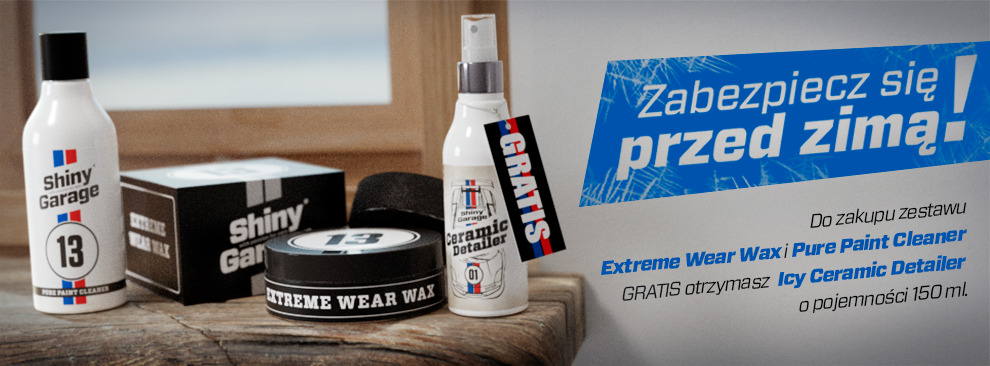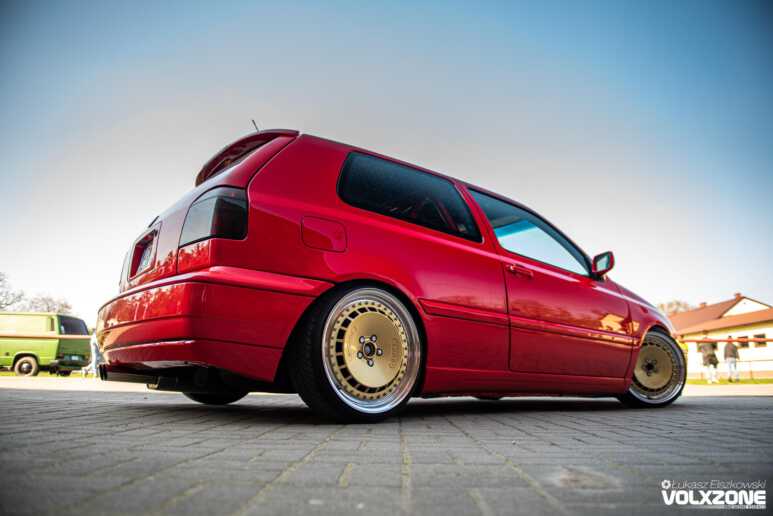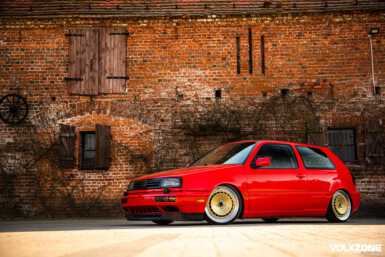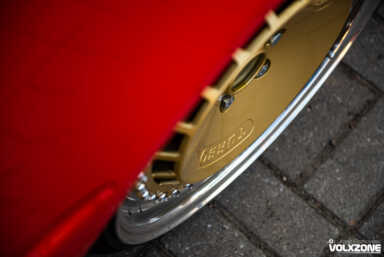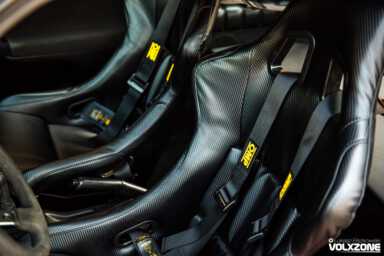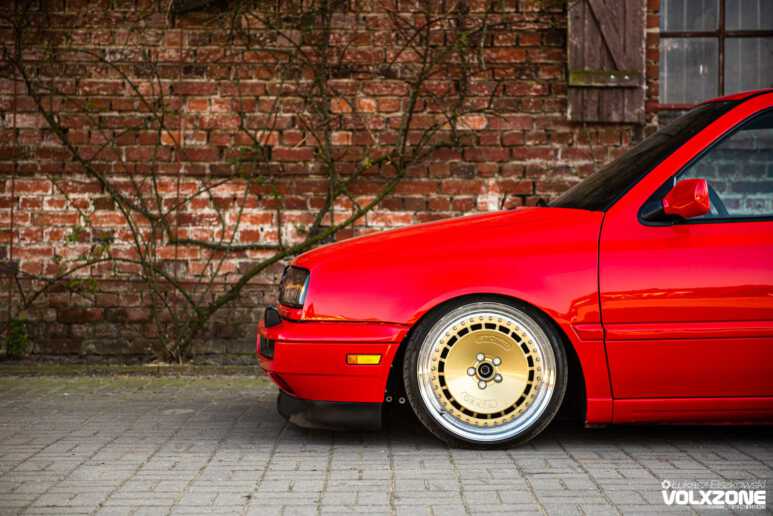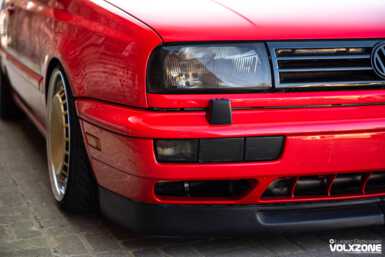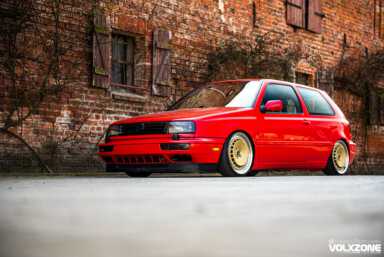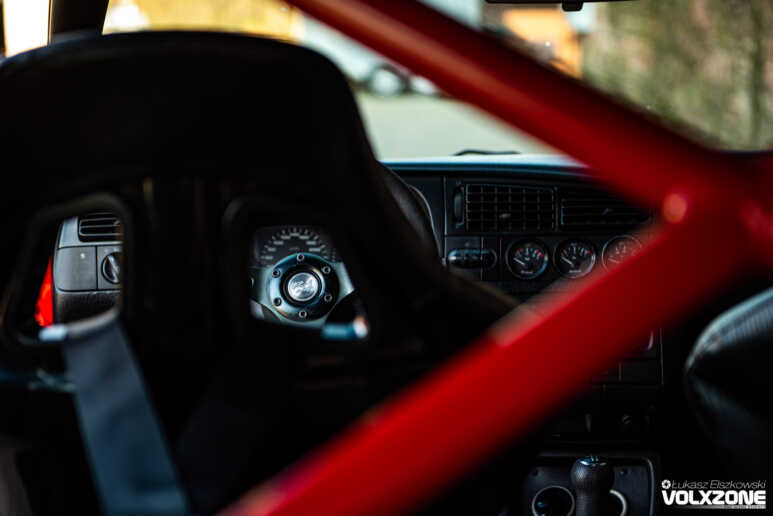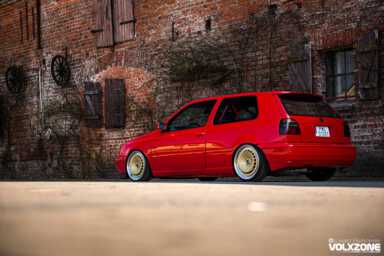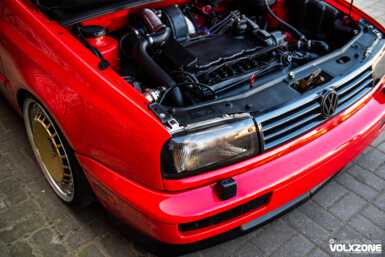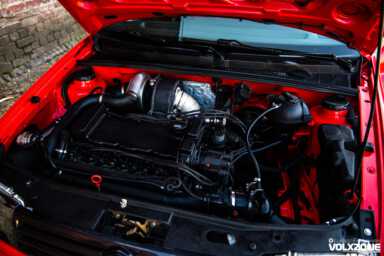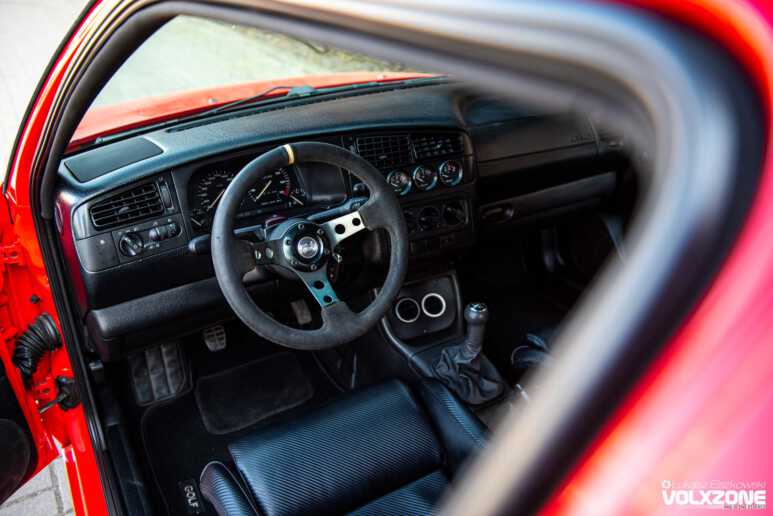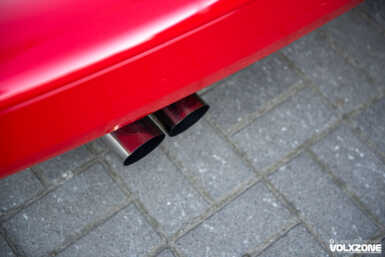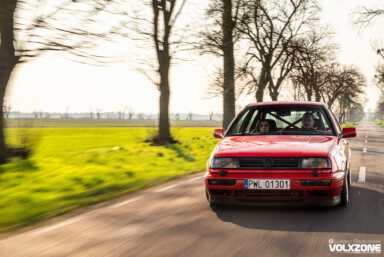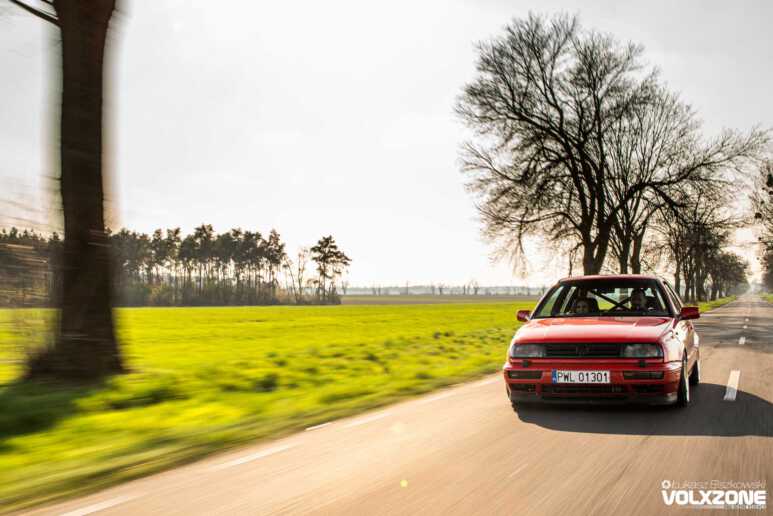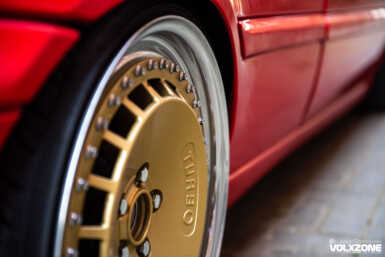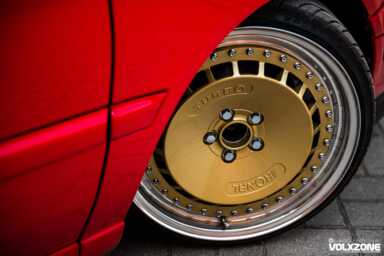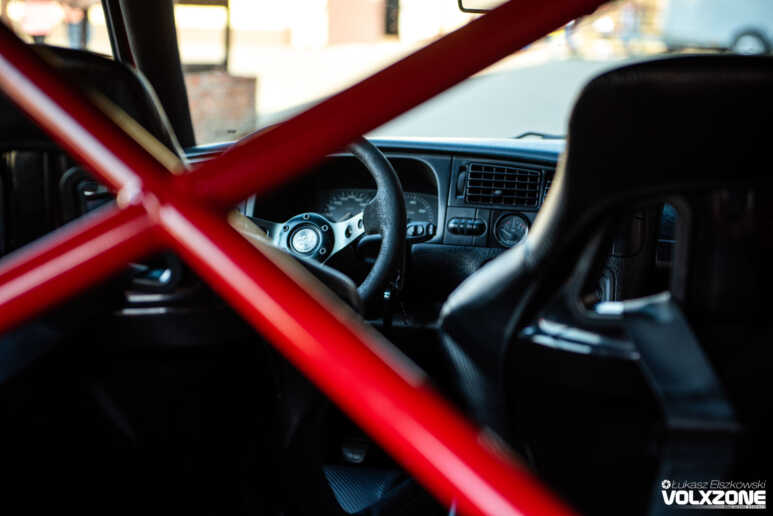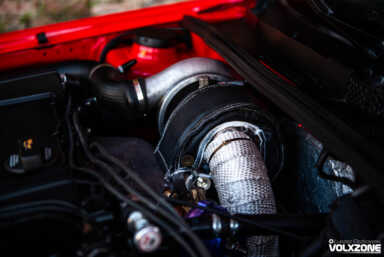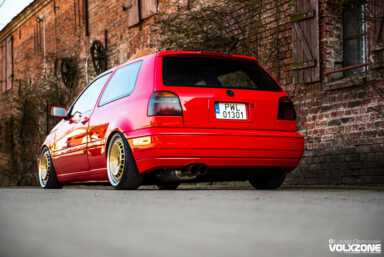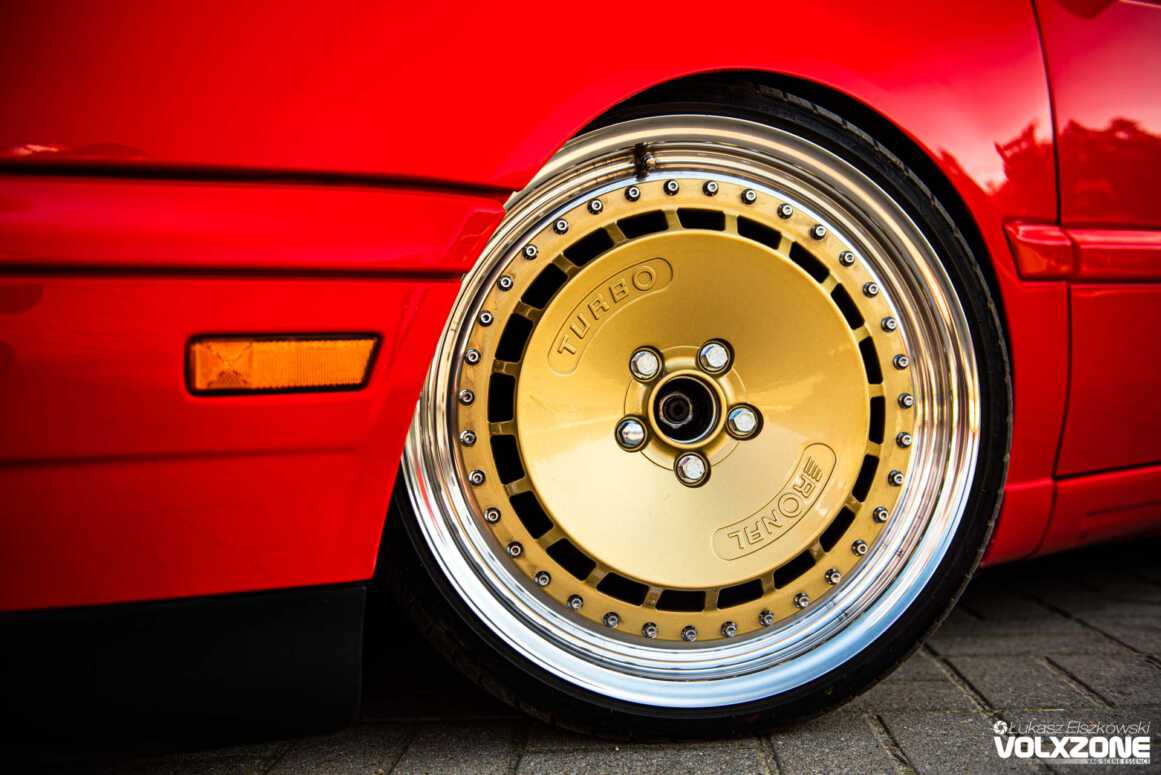
Podobno czerwone auta są szybsze. Nawet gdyby tak było, to przecież nie zaszkodzi pomóc losowi i sprawić, by ich osiągi były jeszcze lepsze. Z tego założenia wyszedł nasz dzisiejszy bohater.
![]()
Apparently, red cars are faster. Even if so, it would not hurt to help fate and make their performance even better. Our hero have done it that way.

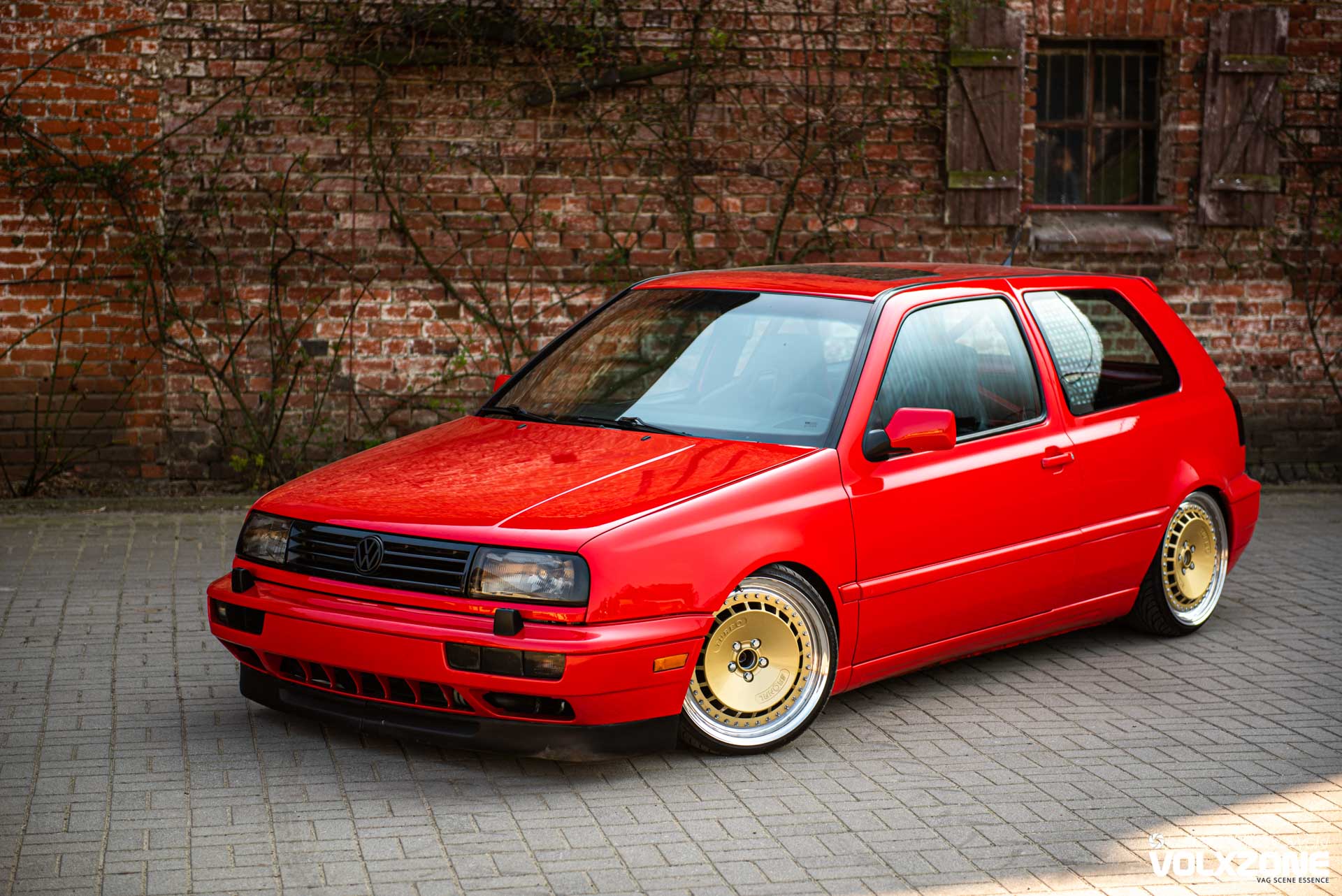
Nigdy nie ukrywałem, że Golf Mk3 jest dla mnie najmniej ciekawym spośród wszystkich generacji. Nie chodzi nawet o stan, w jakim ten model opuścił bramy fabryki, ale o fakt, że wszystkie zmodyfikowane egzemplarze wyglądają praktycznie tak samo. Przynajmniej tak jest dzisiaj, kiedy wraz z ewolucją trendów na scenie króluje klimat OEM+. Przeglądając stare niemieckie magazyny poświęcone VW bez trudu można natknąć się na projekty w bardzo różnych klimatach, a wiele z nich nawet dziś mogłoby wywołać zamieszanie na najbardziej prestiżowych imprezach. Tak czy siak, nie będę się rozwodził nad przeszłością, ani nie mam zamiaru używać frazesów w stylu ‘kiedyś do było…’. W końcu dzisiaj też można poczuć satysfakcję z patrzenia na czyjś zupełnie współczesny projekt, wystarczy tylko wiedzieć gdzie takich szukać. Właśnie dlatego spotkaliśmy się z Piotrem Początkiem i jego czerwonym Mk3 3.0 VR6T, którzy za pomocą zdjęć i tekstu sami opowiedzą swoją historię.
![]()
I have never concealed that Golf Mk3 is the least interesting for me of all generations. It is not even about the state in which this model left the factory gates, but about the fact that all modified cars look practically the same. At least, that’s the way it is today when, along with the evolution of trends, the OEM+ atmosphere reigns on the stage. Looking through old German magazines dedicated to VW, you can easily come across projects in very different climates, and many of them even today could cause confusion at the most prestigious events. Either way, I will not dwell on the past, nor do I intend to use 'once upon a time’ phrases. Finally, today you can feel the satisfaction of looking at someone else’s completely contemporary project, all you have to do is know where to look for them. That is why we met with Piotr Początek and his red Mk3 3.0 VR6T, who will tell their story using photos and text.
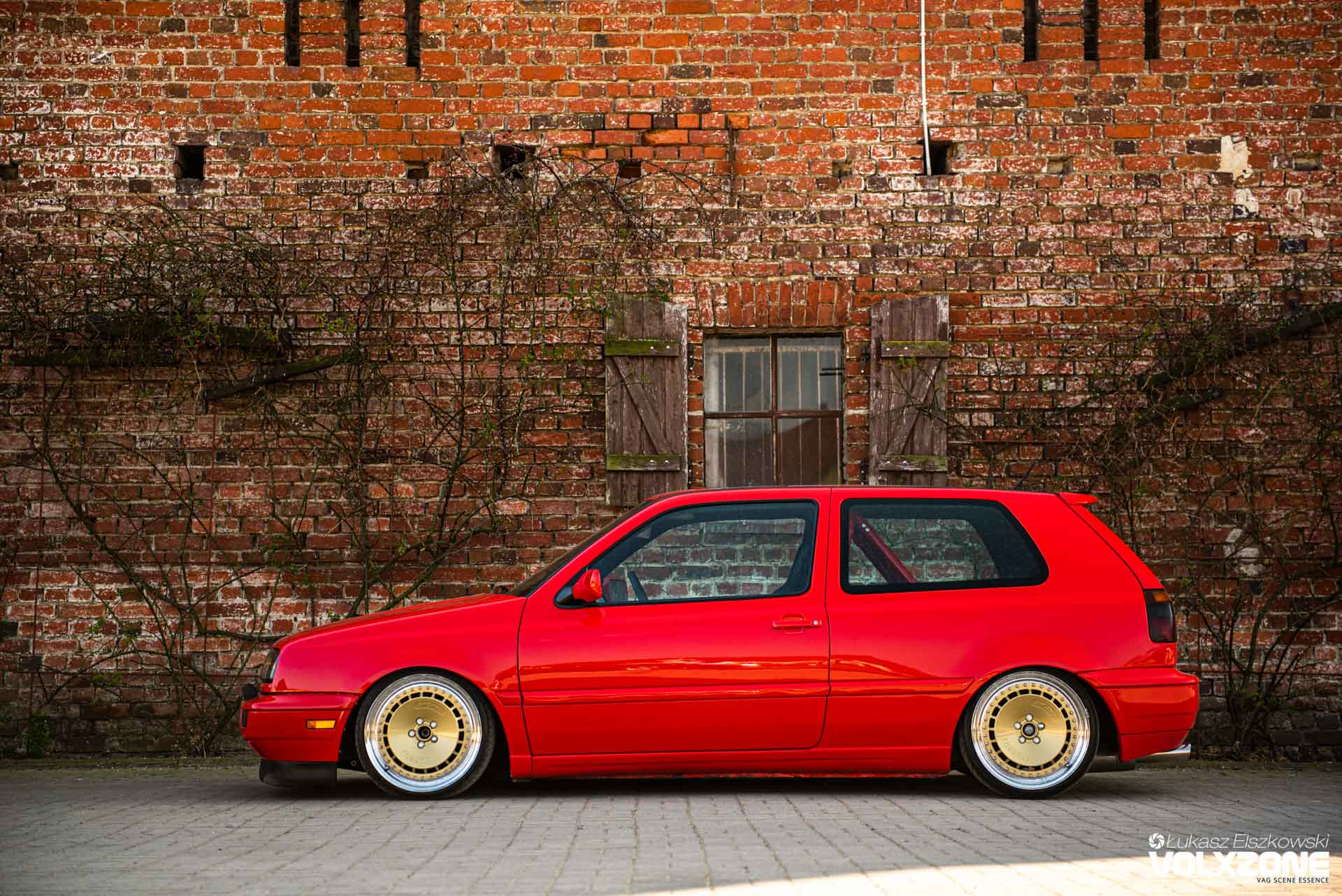
VXZ: Pierwsze pytanie nie może być inne: jak i kiedy rozpoczęła się Twoja pasja związana z motoryzacją, tuningiem i samochodami z Wolfsburga?
P.P: Pasja do motoryzacji i tuningu zaczęła się jakieś 10 lat temu, jak jeszcze nie mając prawka z kumplem Arturem kupiliśmy sobie skutery [Mk1 R32 Artura opisywaliśmy już na łamach VOLXZONE- przyp. Red.]. Co piątek robiliśmy rundkę po okolicy, kończąc u Artura w garażu. Zawsze też nasłuchiwaliśmy jak gość z okolicy jeździł Corrado 2.9 VR6. W tym momencie urodził się pomysł na własne auto i tuning.
![]()
VXZ: The first question cannot be different: how and when did your passion for motoring, tuning and cars from Wolfsburg begin?
P.P: The passion for motoring and tuning began about 10 years ago, as we didn’t have a license with my friend Artur, we bought scooters [Artur’s Mk1 R32 we have already described in VOLXZONE – ed.]. Every Friday we did a round of the area, ending up at Artur’s garage. We’ve also always listened to a Corrado 2.9 VR6 from nearby. At that moment the idea for own car and tuning was born.
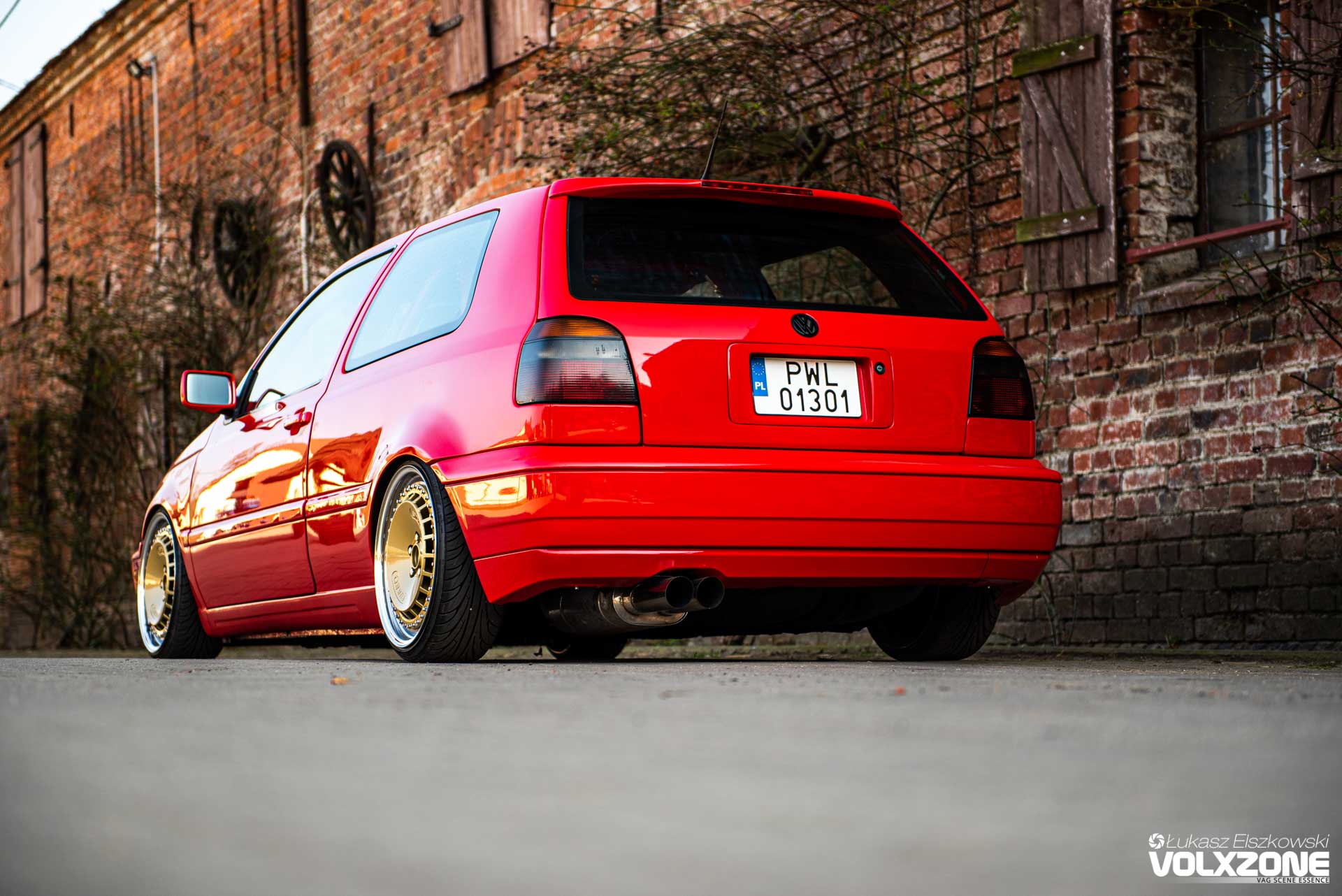
VXZ: Dlaczego spośród niezliczonej liczby marek wybrałeś akurat ‘nudne’ niemieckie auta dla ludu?
P.P: Od początku przeglądając Internet i gazety moją uwagę przykuwały VW, a konkretnie Golfy. Kiedy nastała chwila na wybór pierwszego własnego samochodu, bez wahania wybrałem VW.
VXZ: Jak więc wyglądała Twoja przygoda z motoryzacją po przesiadce ze skutera na cztery kółka? W jakich okolicznościach stałeś się posiadaczem widocznego na zdjęciach egzemplarza?
P.P: Pierwszym autem był Golf Mk3 1.6 Cat w wersji CL, który stał się podstawą dla mojego obecnego auta. Po roku od zakupu Golfa wystawiłem go na sprzedaż i zakupiłem Mitsubishi Colt. Jednak od samego początku wiedziałem, że to był błąd. Wystarczyło jedno spotkanie z Arturem, bym zmienił plany. Ostatecznie postanowiłem jednak pozostawić Golfa, a sprzedać Colta. Wszystko działo się w roku 2010, Golf został zakupiony dwadzieścia kilometrów od domu, od ojca mojego kumpla ze szkoły.
![]()
VXZ: Why did you choose „boring” German cars for people from countless brands?
P.P: From the beginning, browsing the Internet and newspapers VW’s caught my attention, specifically Golfs. When it was time to choose my first car, I chose VW without hesitation.
VXZ: So what was your adventure with the car like after switching from a scooter to four wheels? In what circumstances did you become the owner of the copy visible in the pictures?
P.P: The first car was Golf Mk3 1.6 Cat in the CL version, which became the basis for my current car. A year after I bought the Golf, I put it up for sale and bought a Mitsubishi Colt. However, from the very beginning I knew it was a mistake. One meeting with Artur was enough for me to change my plans. Ultimately, I decided to leave Golf and sell Colt. Everything happened in 2010, Golf was bought twenty kilometers from home, from my school friend’s father.
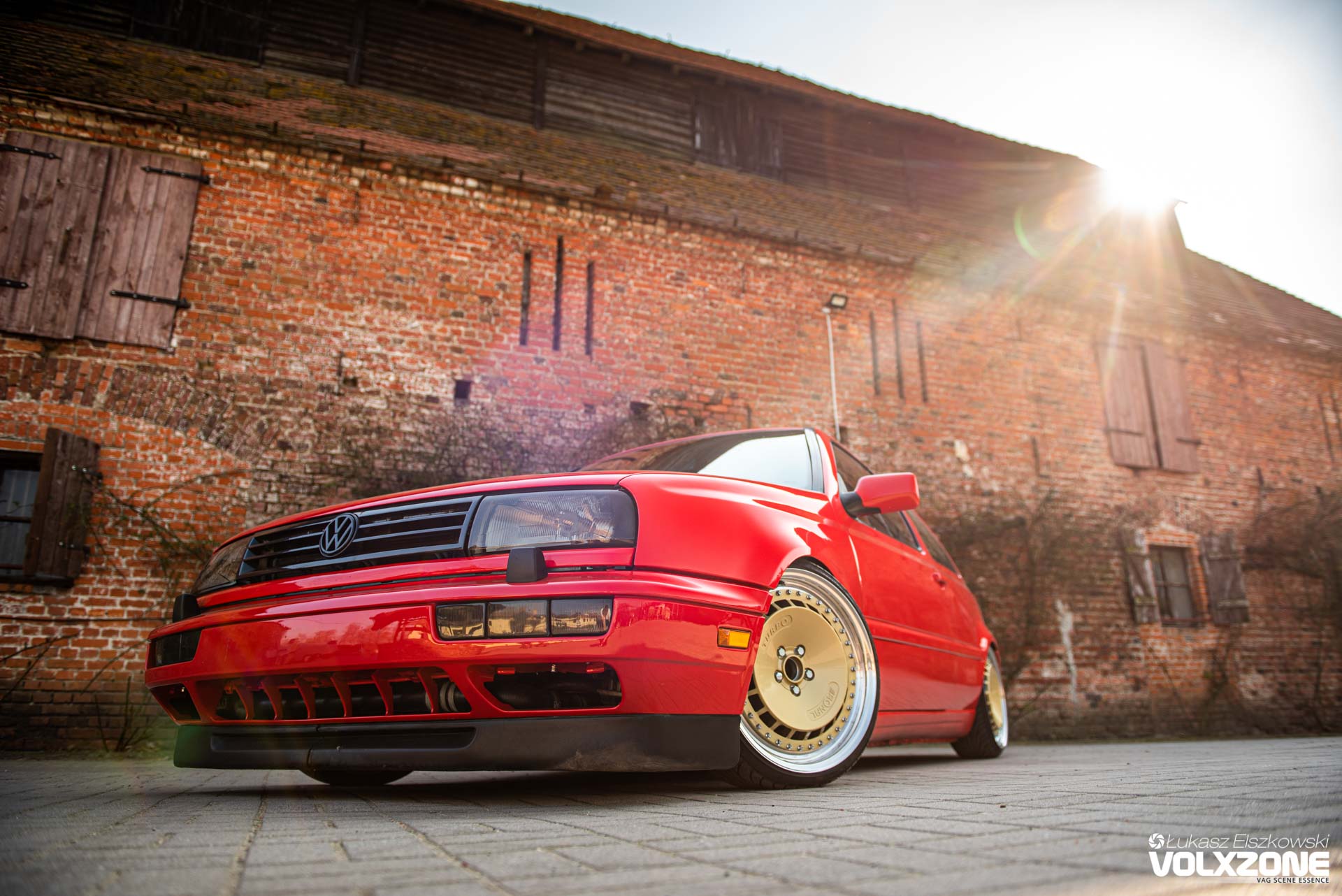
![]()
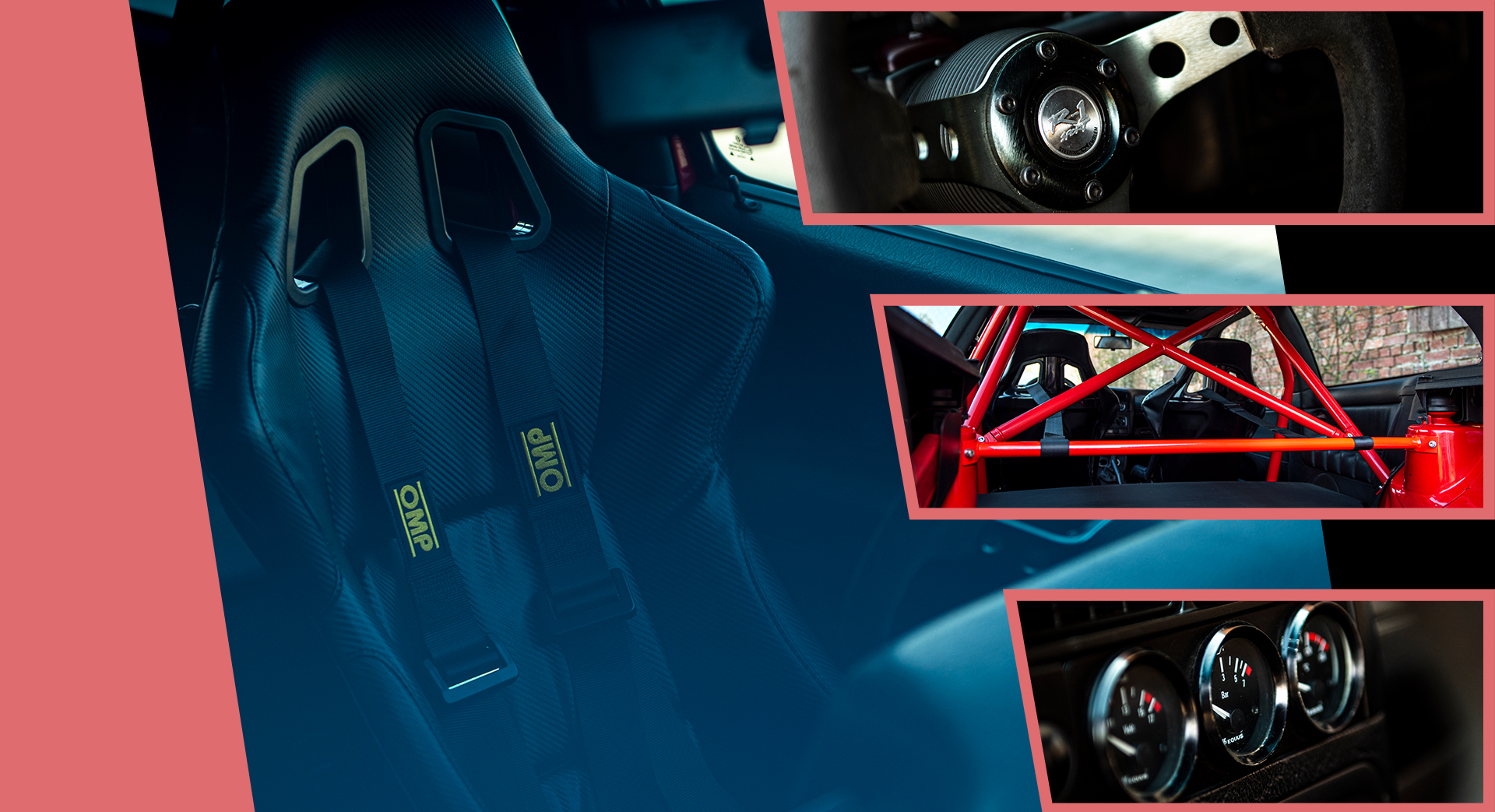
![]()
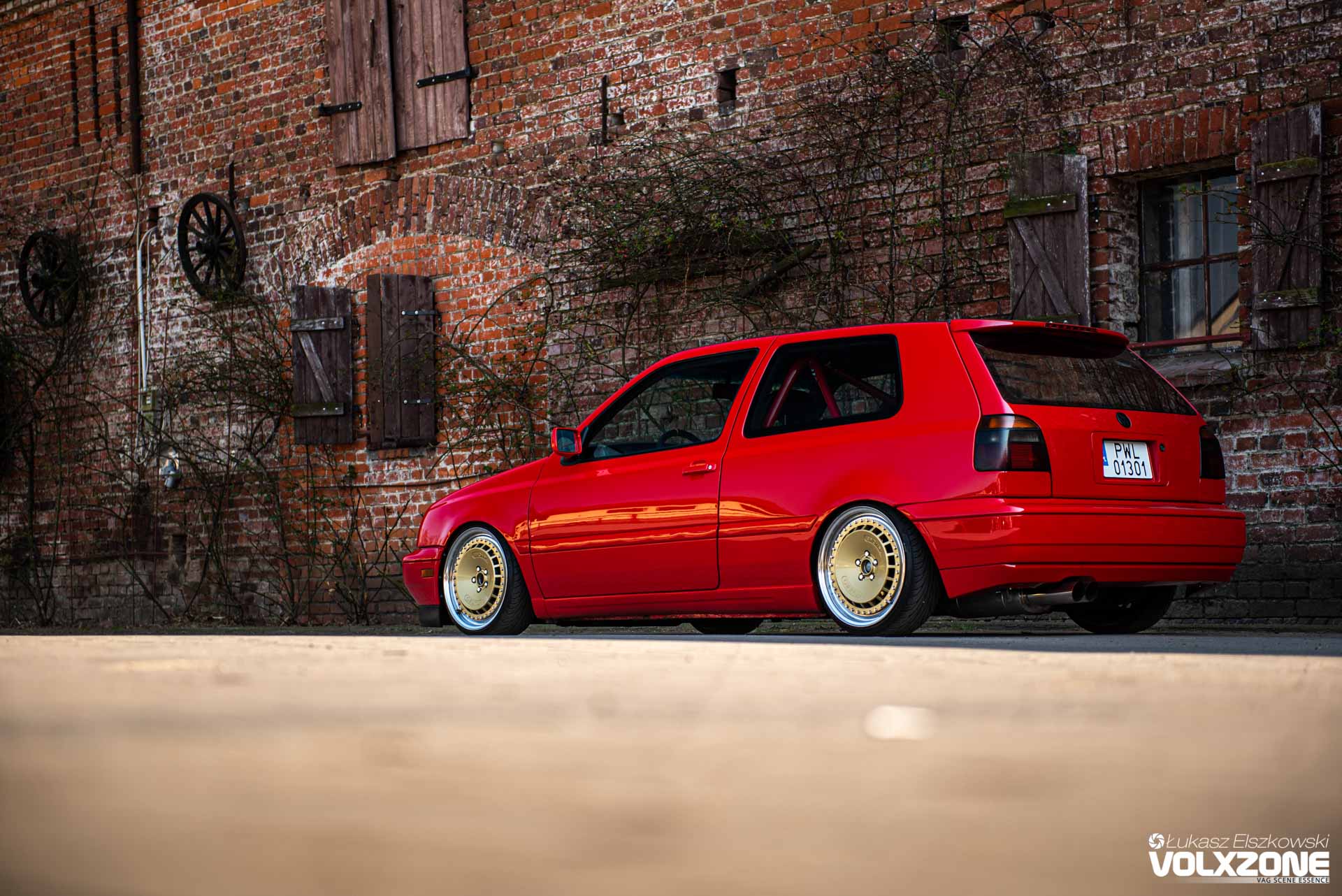
VXZ: Czy zaczynając projekt miałeś w głowie konkretną wizję tego, jak auto ma wyglądać finalnie?
P.P: Właściwie nie miałem konkretnych planów co do tego auta. Z czasem rodziły się nowe pomysły, zależne oczywiście od budżetu, jaki miałem na dany moment.
VXZ: When starting the project did you have a specific vision of how the car should look like in the end?
P.P: Actually, I had no specific plans for this car. Over time, new ideas were born, depending of course on the budget I had at the moment.
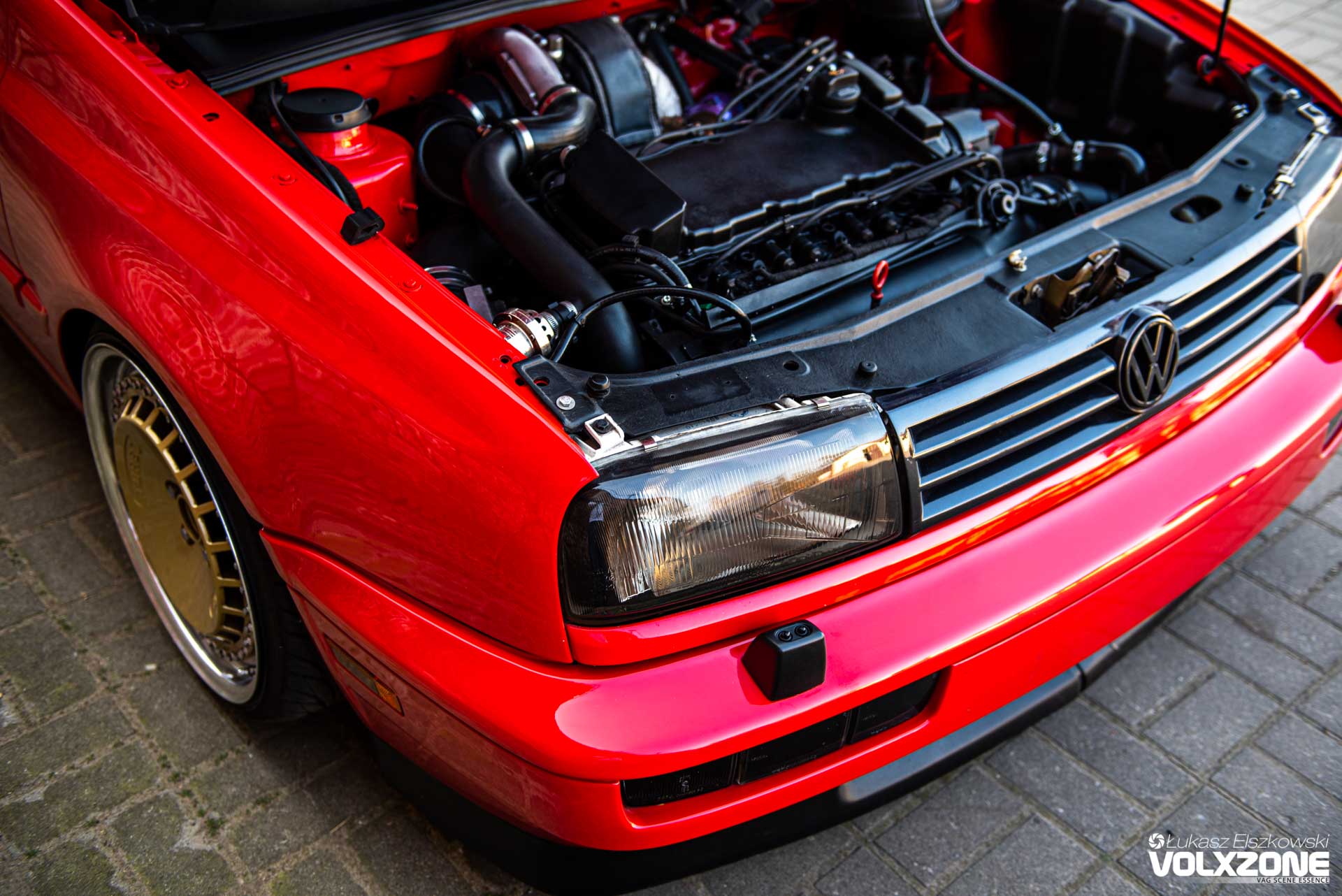
![]()
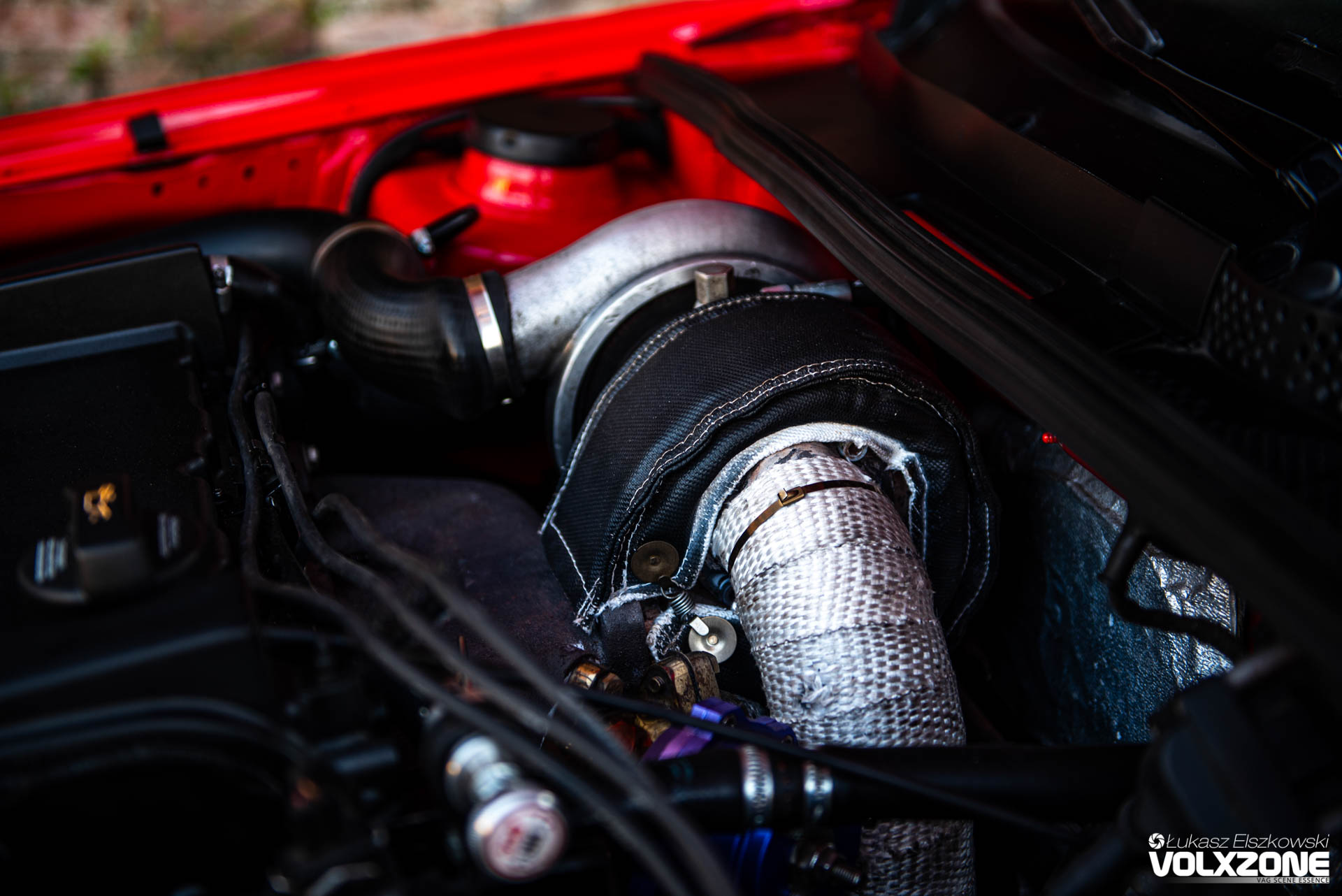
![]()
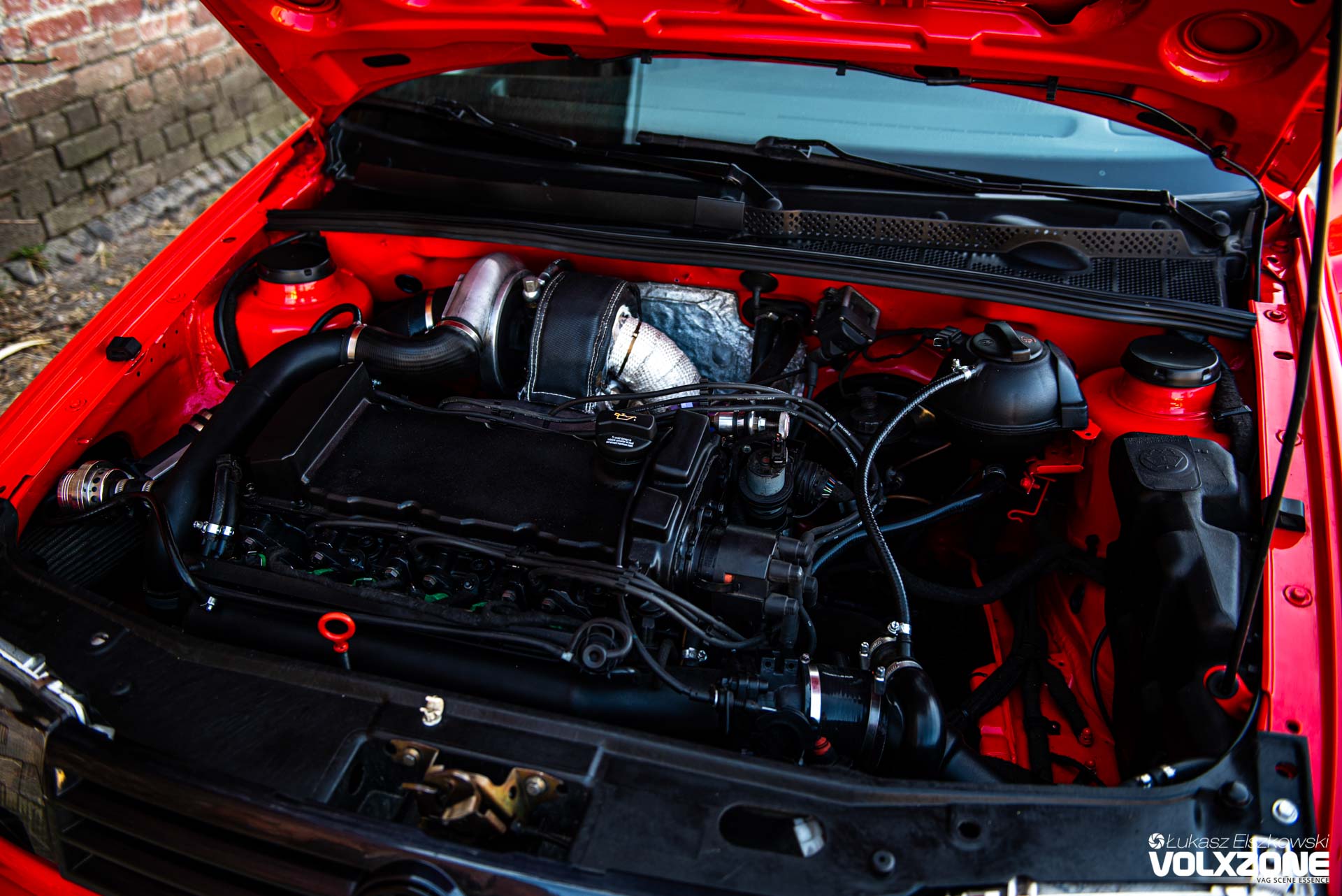
VXZ: Jak już prace ruszyły, jak przebiegały ich etapy?
P.P: Modyfikacje rozpocząłem od zmiany kół na szeroką stal. Później zaszły modyfikacje w środku, w tym zmiana foteli, potem wydechu na sportowy. Po odłożeniu kwoty na nowy silnik dokonałem swapa na 2.8 VR6. W takim stanie Golf pojeździł rok. Następnie po wyjęciu silnik został rozwiercony do pojemności 3.0 i uturbiony. Następnie auto pojechało do blacharza i zostało pomalowane na obecny kolor. Po powrocie do domu został złożony- to było jakieś pięć lat temu.
VXZ: W którym miejscu pojawiły się największe trudności?
P.P: Najtrudniejszy w całej przebudowie był silnik. Jego montaż, jego wygląd zewnętrzny oraz strojenie, które odbywało się na pasie startowym w Kąkolewie. Również ‘kasta’ dała mi się we znaki, by zgrać wszystkie elementy w dopasowaną całość.
VXZ: Jaki jest efekt prac pod maską?
P.P: Obecnie jest to 400 koni mechanicznych.
VXZ: Jest jakiś obszar projektu, który jest Twoim ulubionym?
P.P: Zdecydowanie ulubionym elementem projektu jest komora silnika.
![]()
VXZ: When the works started, how did their stages go?
P.P: I started the modifications by changing the wheels to wide steel. Later, there were modifications inside, including a change of seats, then exhaust to sports. After putting aside the amount for the new engine I swap for 2.8 VR6. In this condition, Golf has driven a year. Then after removing the engine was bored to 3.0 and turbocharged. Then the car went to the painter and was painted in the current color. After returning home, he was made – it was about five years ago.
VXZ: Where did the biggest difficulties occur?
P.P: The engine was the most difficult in the entire reconstruction. Its assembly, its external appearance and tuning, which took place on the runway in Kąkolewo. Also, „caste” gave me a hard time to rip all the elements into a matching whole.
VXZ: What is the effect of working under the hood?
P.P: It is currently 400 horsepower.
VXZ: Is there any area of the project that is your favorite?
P.P: The engine compartment is definitely the favorite element.

![]()
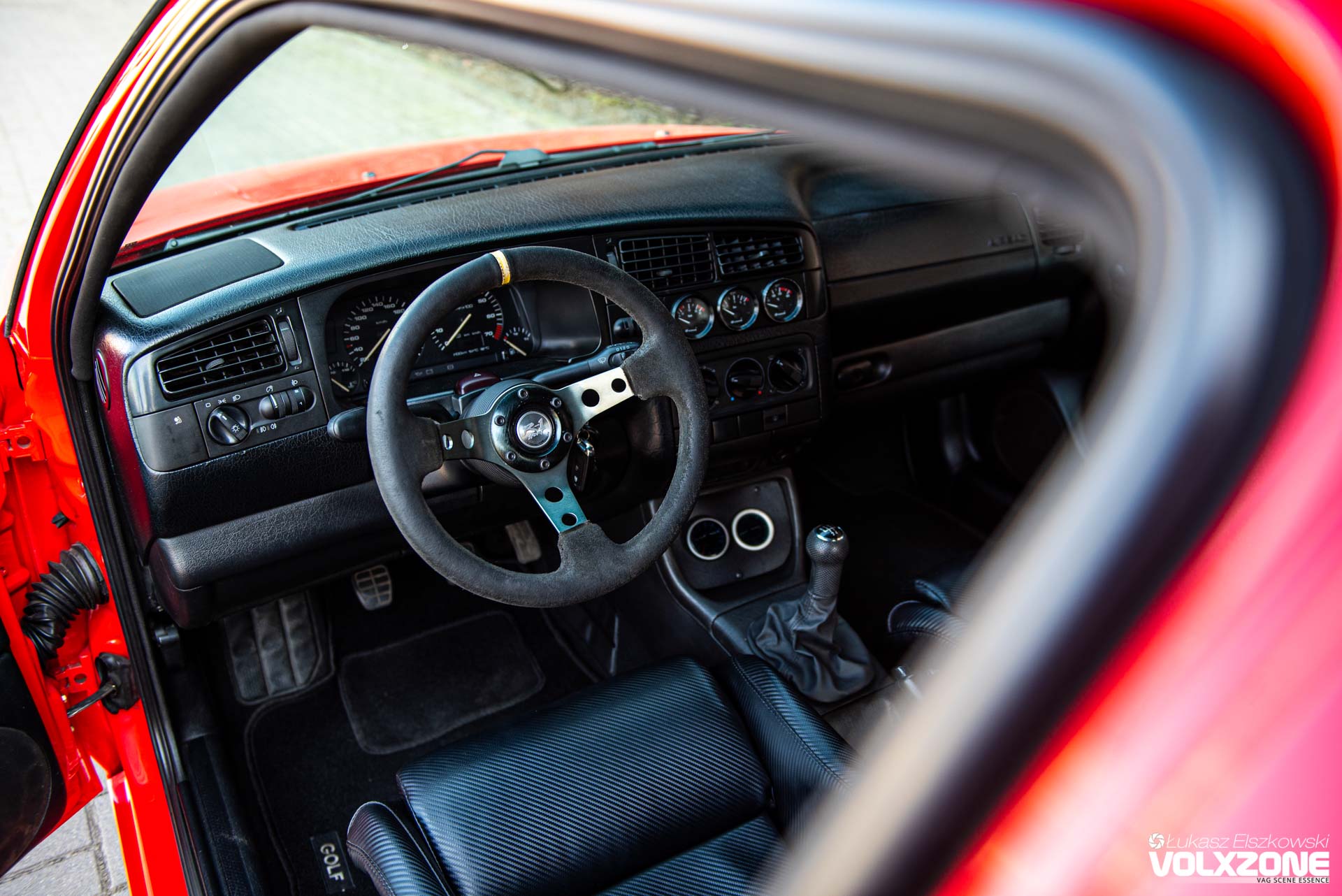
![]()
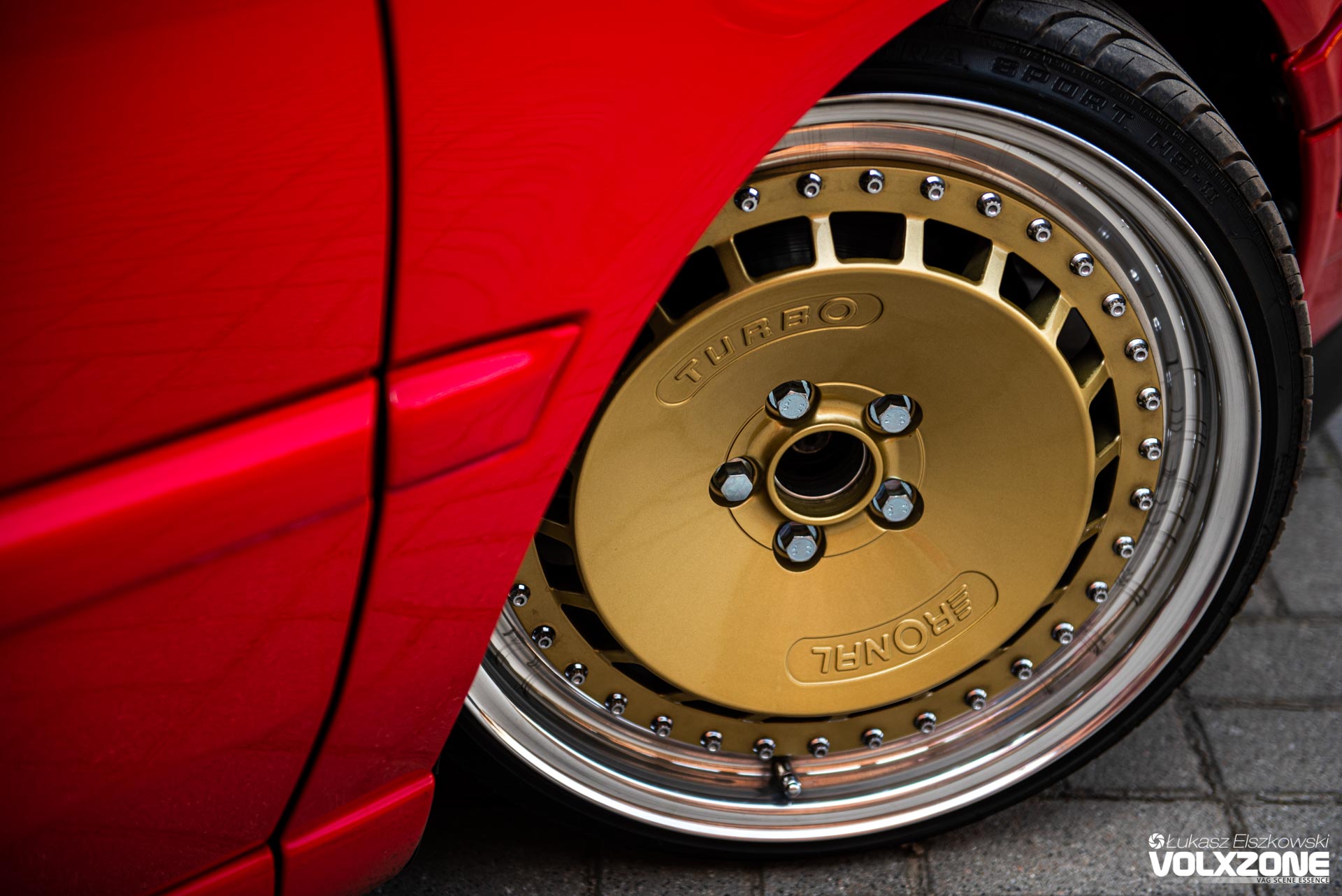
VXZ: Jednym z najbardziej rzucających się w oczy elementem Twojego auta są felgi. Powiedz na ich temat coś więcej, bo choć niektórym może się wydawać, że ten model dobrze znają, to nic w tym bardziej mylnego.
P.P: Zawsze podobały mi się customy z wystającymi rotorami. Po długich poszukiwaniach znalazłem wymarzone felgi Ronal Turbo, które były odpowiednią baza pod obecny projekt. Wykonanie rotoru zleciłem firmie ze Śląska, którą znalazłem w Internecie i ustaliłem z nią szczegóły dotyczące oczekiwanego wyglądu całości. Najtrudniejszy w tym procesie był moment dopasowania rotoru z ranto-bębnami, które przygotowywałem sam. Po dostarczeniu do mnie przerobionych rotorów nastał czas na osadzenie ich w ranto-bębnach o szerokości 8″. Po skręceniu zostały założone opony Nakanng 185/35/17.
![]()
VXZ: One of the most striking elements of your car are the rims. Tell more about them, because although it may seem to some that they know this model well, nothing is more wrong.
P.P: I’ve always liked customs with protruding rotors. After a long search, I found my dream Ronal Turbo rims that were the right base for the current project. I commissioned a company from Silesia, which I found on the Internet, to make a rotor, and agreed with them on the expected appearance of the whole. The most difficult in this process was the moment of matching the rotor with lip-cylinders, which I prepared myself. After delivering the converted rotors to me, it was time to put them in 8″ wide lip-cylinders. After fixing, Nakanng 185/35/17 tires were installed.
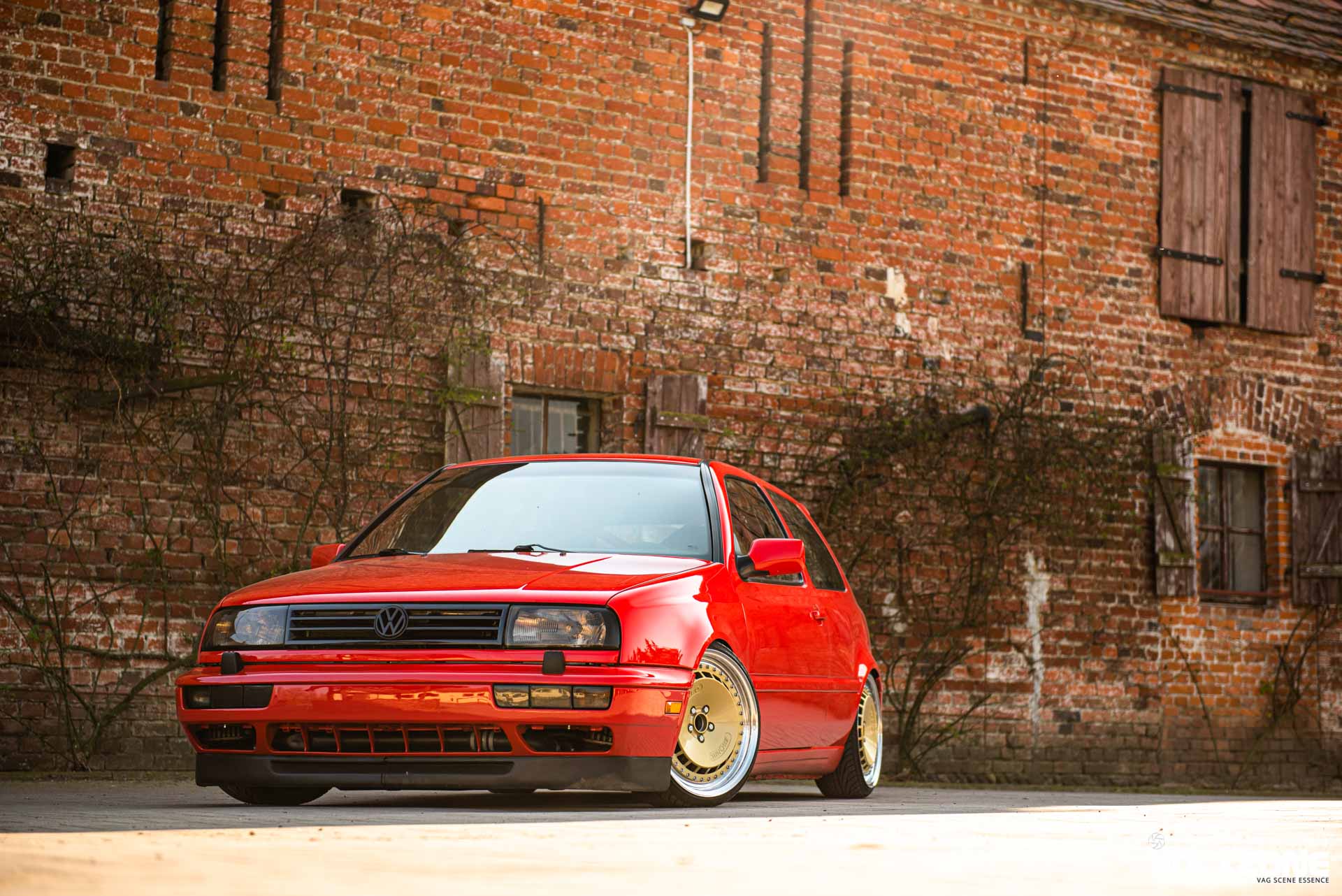
![]()
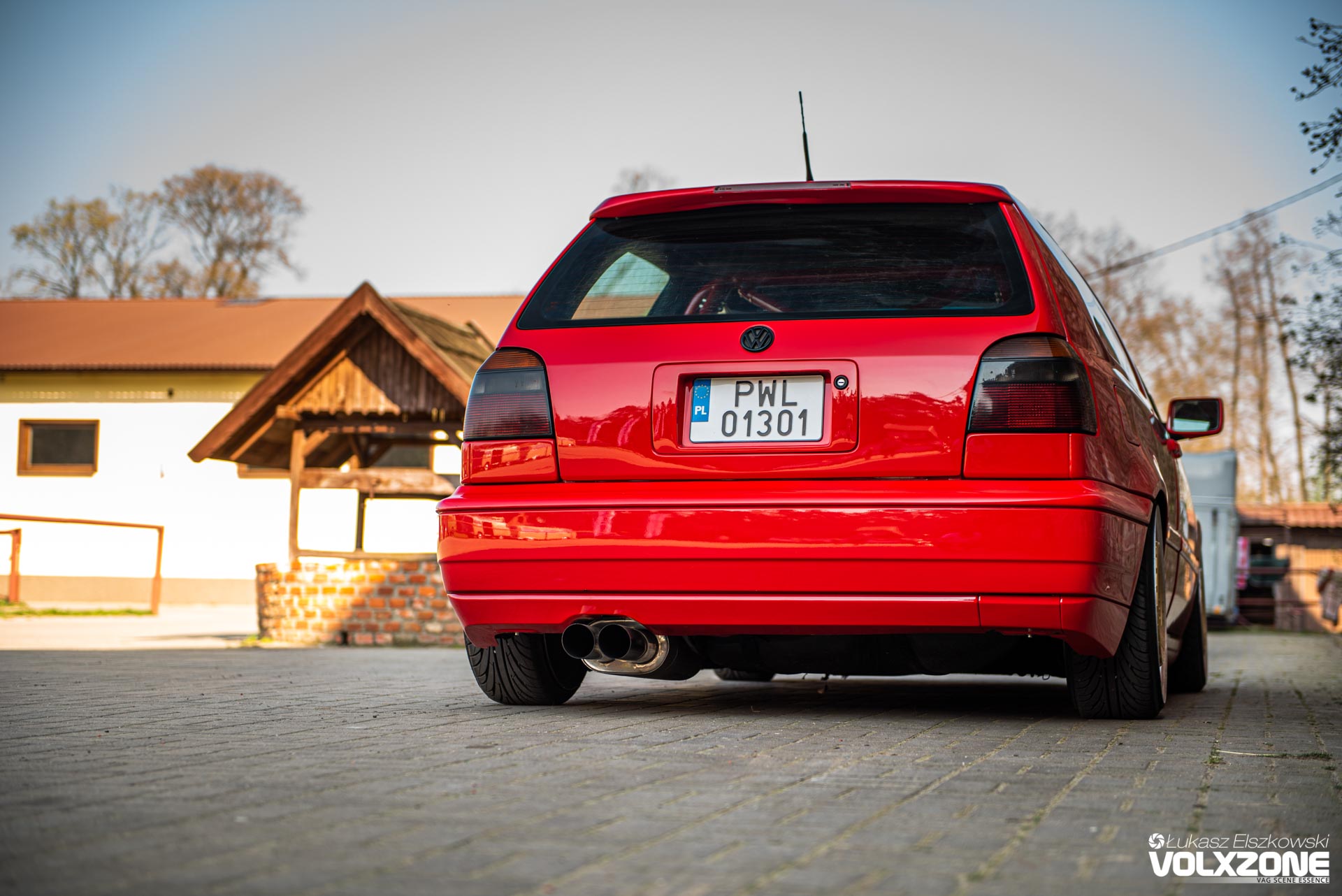
![]()
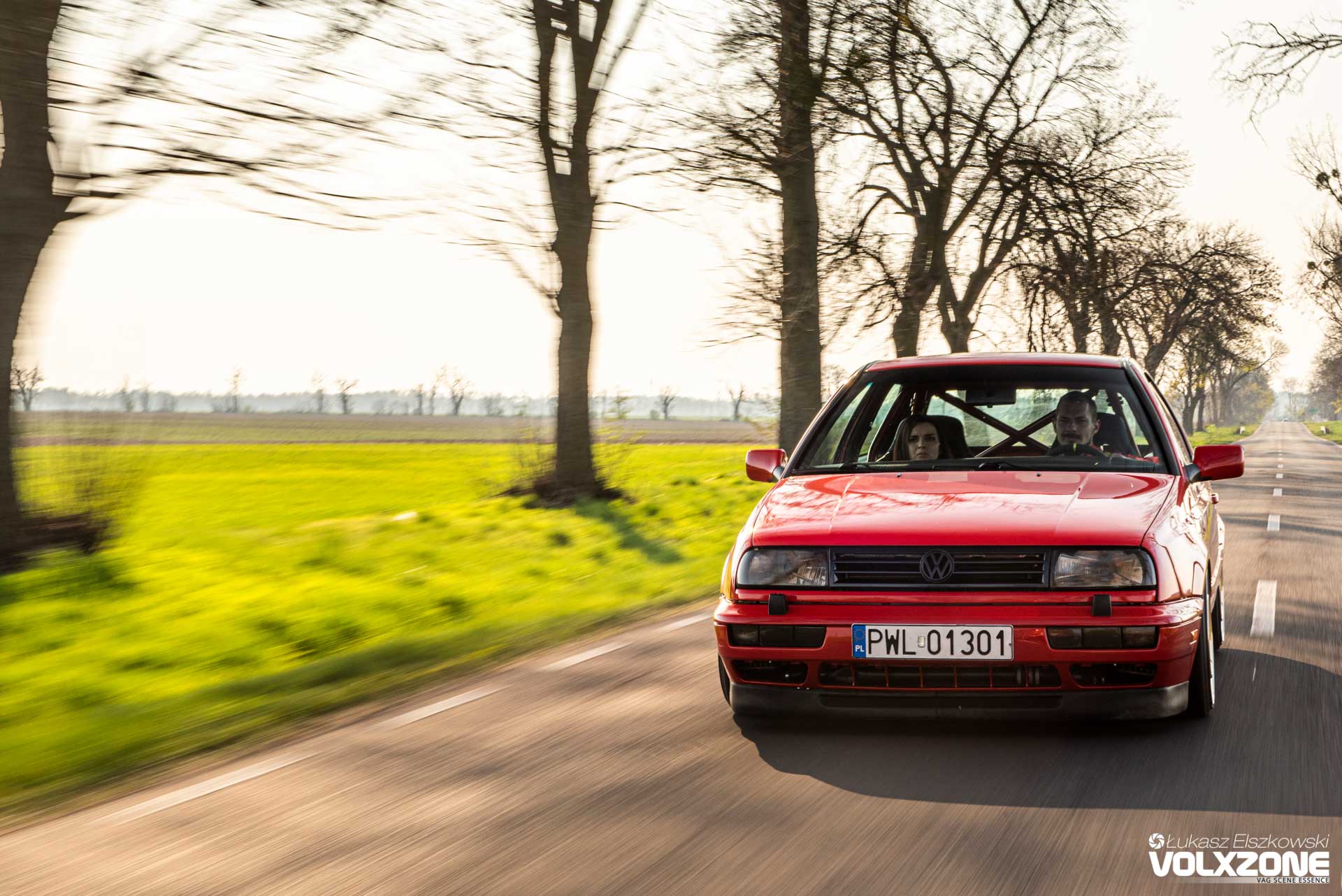
VXZ: Na pierwszy rzut oka Golf wygląda na skończony projekt. Myślisz o kolejnych modyfikacjach, czy planujesz zmienić auto na coś innego?
P.P: Auto bez dwóch zdań zostanie ze mną do końca.
VXZ: Komu chciałbyś podziękować za pomoc w budowie?
P.P: W pierwszej kolejności chciałbym podziękować mojemu przyjacielowi Arturowi, bez którego nie dał bym rady dokończyć projektu, oraz wszystkim tym, którzy przyczynili się do powstania tego projektu: lakiernik, blacharz, firmie Małecki Motosport Poznań.
VXZ: Dziękuję za rozmowę.
![]()
VXZ: At first glance, Golf looks like a finished project. Are you thinking about further modifications or are you planning to change the car to something else?
P.P: The car will definitely stay with me until the end.
VXZ: Who would you like to thank for your help in building?
P.P: First of all, I would like to thank my friend Artur, without whom I could not finish the project, and all those who contributed to the creation of this project: painter, tinner, Małecki Motosport Poznań.
VXZ: Thanks for the conversation.
![]()
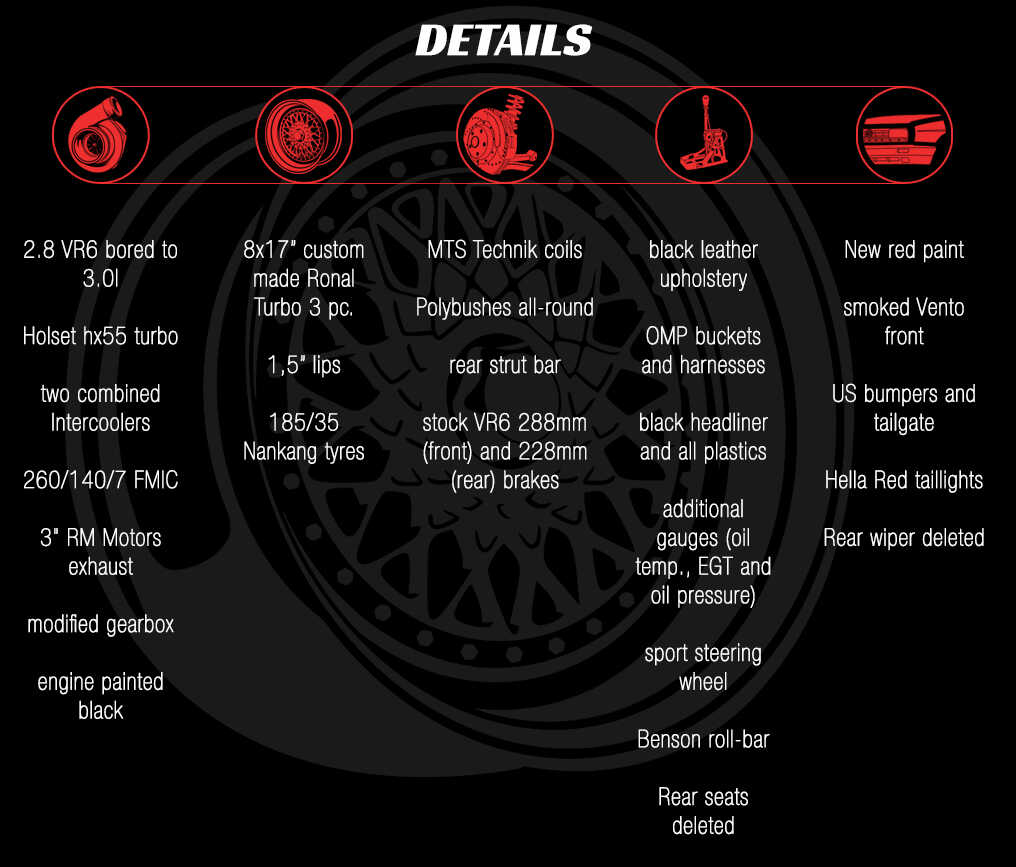

PEŁNA GALERIA | FULL GALLERY


